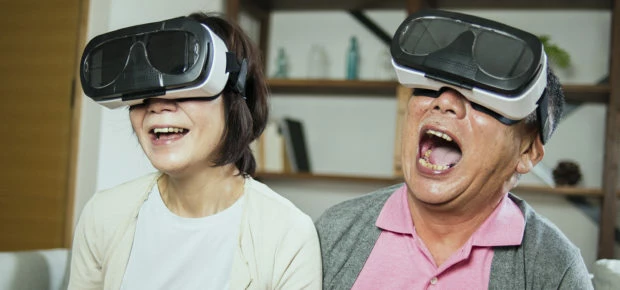
Member Article
Improving sensory experience in Virtual Reality
To date, much of the innovation we’ve seen with virtual reality (VR) has focused on optics and the ability to create believable landscapes for users to interact with. But researchers worldwide aren’t stopping there; strides are being made to create more believable experiences for touch, sound and smell as well.
At École Polytechnique Fédérale de Lausanne in Switzerland, researchers are focused on the importance of passive haptic feedback in making simulations feel believable. At the most basic level, this centres on the experience of touching one’s own body while controlling an avatar: “When carefully treated, the body may act as a free source of high fidelity haptic feedback; if neglected however, it will cause inconsistencies that will lessen the impact of any full-body tracked application.”
Making the experience of self-contact consistent has an outsize effect on making the virtual feel real, since people are more sensitive to inconsistencies than they are to precise movements, the researchers say. As motion capture devices become better and cheaper, this should be increasingly achievable.
Part of being truly immersed in a simulation is having it sound realistic. At Chung-Ang University in South Korea, work is being done to build wireless speakers that can detect their position in a speaker setup and adjust their output accordingly. Using a speaker, a Raspberry Pi and a beacon, the author was able to get great accuracy with the speakers 3-4 meters apart. While surround-sound systems obviously exist already, this would allow for simple setup anywhere, eliminate wires and make the experience safer and more convincing for the user.
Lastly, in what’s perhaps the most radical approach, researchers in Malaysia are working on digitising smell so that it can be replicated anywhere. Moving away from cartridges that contain chemicals, this approach uses electric current delivered directly to the nasal cells, which causes the recipient to perceive odors that aren’t there. While this was an uncomfortable and early-stage proof of concept, strides in this area would be exciting for VR and many different experiences online.
Sight remains of particular importance, so it’s still worth mentioning here. Researchers from Deakin University in Australia looking at the effects of virtual environments on our mental and cognitive states wrote a paper assessing visual fatigue from VR, which they say is more mental than muscular, since the brain gets overloaded with conflicting signals. While they faced a number of challenges in this pursuit, the work stands to have important implications for improving headset and display design.
This was posted in Bdaily's Members' News section by IEEE .




 test article 123456789
test article 123456789
 hmcmh89cg45mh98-cg45hm89-
hmcmh89cg45mh98-cg45hm89-
 test456456456456456456
test456456456456456456
 test123123123123123123
test123123123123123123
 test xxxdiosphfjpodskhfiuodsh
test xxxdiosphfjpodskhfiuodsh
 Savour the flavour: North Tyneside Restaurant Week returns for 2024
Savour the flavour: North Tyneside Restaurant Week returns for 2024
 Six steps to finding the right buyer for your business
Six steps to finding the right buyer for your business
 Stephen signs off on a special night
Stephen signs off on a special night
 Life’s a Peachaus: Gillian Ridley Whittle
Life’s a Peachaus: Gillian Ridley Whittle
 Making a splash: Phil Groom
Making a splash: Phil Groom
 Making workplace wellbeing a priority
Making workplace wellbeing a priority
 A record of delivery, a promise of more: Ben Houchen
A record of delivery, a promise of more: Ben Houchen